On test: RS Agri targets muckspreader market with new Atlas
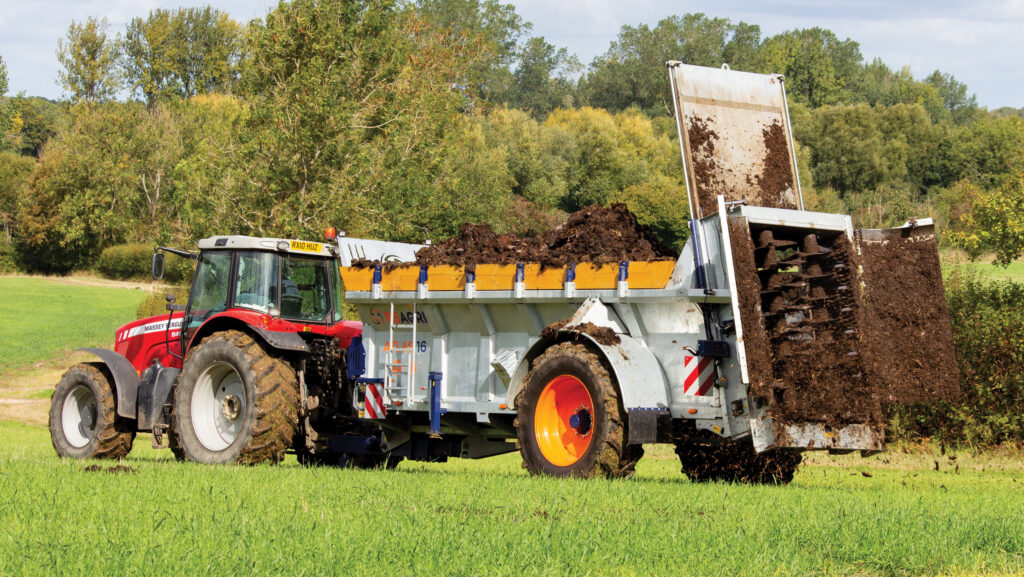
Feeding and bedding specialist RS Agri has broadened its offering with a range of complementary machines to dispose of soiled livestock litter.
Like its ration mixers, the six new vertical beater muckspreaders, running from 9t to 16t, are built to a heavy-duty specification in Poland.
See also: Muck and slurry field equipment: Where is it made?
RS Agri Atlas 16t
- Load capacity 16t
- Heaped capacity 16.8cu m
- Length x width 9.2×2.95m
- Beater diameter 820mm; 32 tips
- Spinning disc diameter 780mm
- Spreading width 9-15m
- Tyres 570/70 R38
- Unladen weight 7.1t
- Base on-farm price £33,500
Unsurprisingly, there’s little rip-roaringly new on what surely ranks as one of agriculture’s crudest machines.
Instead, the Basingstoke-based firm has focused on robustness.
It has used plenty of metal – some of it particularly hard-wearing – to make its Atlas models an attractive alternative to the sector’s main protagonists: Bunning, Ktwo and Richard Western.
And, by RS’s reckoning, they should outlast many of their rivals, especially when fitted with a galvanised body and optional stainless-steel walls and floors that should keep the tinworm at bay during months sat idle in the yard.
This will be of particular benefit to occasional users, such as smaller farms that apply their own muck, where spreaders live a largely sedentary life exposed to the elements and vulnerable to degradation.
“As with our mixer wagons, we’ve found people are willing to invest in durability,” says RS Agri director Sam Lloyd.
“That’s not only contractors, some of which are replacing their spreaders every couple of years due to the abuse they get, but also farmers that have, or are planning to, take their spreading back in-house.”
The range is currently made up of vertical beater machines that top out with the flagship 16-tonner we’re focusing on here.
“However, others are in the works, most notably 20-24t, twin-axle horizontal beater models for biosolids and the like.
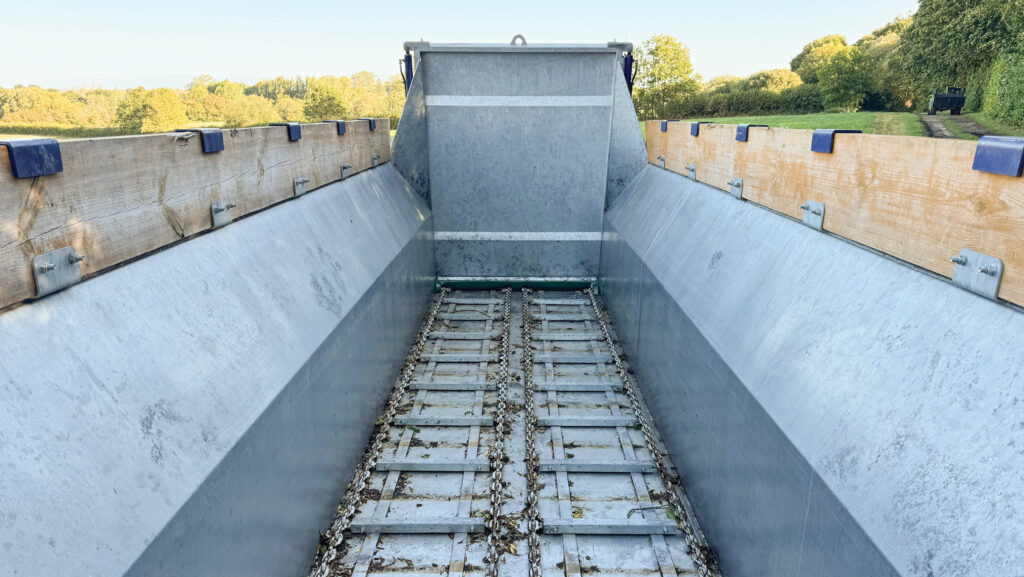
Optional galvanised body should improve longevity © MAG/Oliver Mark
Galvanised body
As mentioned, one of the stand-out features of the Atlas is its optional galvanised body – something also offered by French outfit Pichon and Belgian firm Joskin.
This can be painted in a colour of the buyer’s choosing, should they want something more muted than retina-scorching silver.
The trade-off for improved longevity is a slightly rougher finish than paint alone, which means sticky muck may be inclined to cling to the zinc-lined exterior a little more.
However, the only area where this issue rears its head is on the stone guard that protrudes at a 45deg-ish angle from the top of the front wall.
Here, claggy material is liable to accumulate rather than tumble into the body as the load moves rearwards to the beaters.
RS intends to solve this problem on future models by fitting a more upright extension.
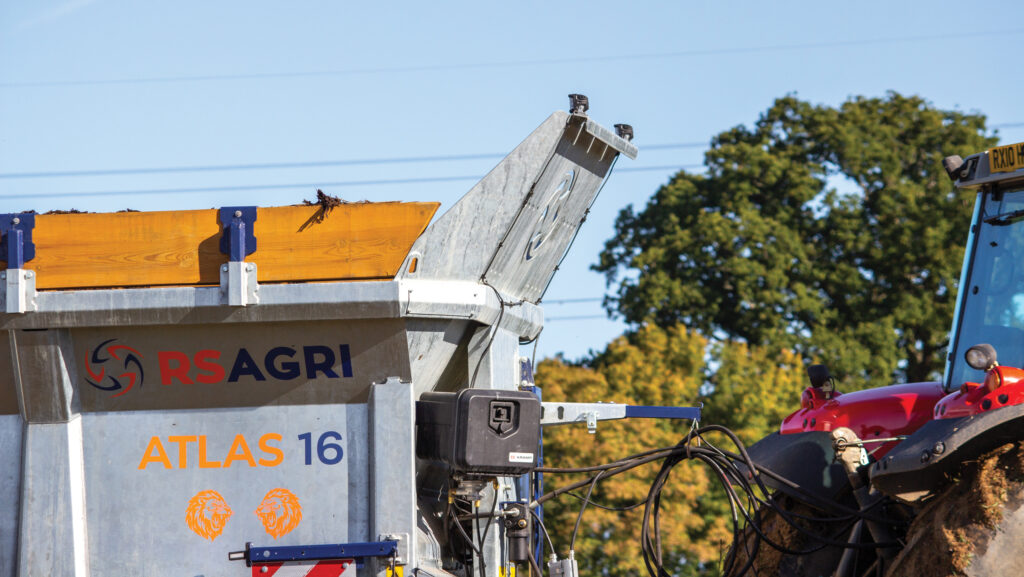
RS Agri will tweak the design of the stone guard © MAG/Oliver Mark
As well as galvanising, buyers spreading caustic materials can throw more money at corrosion protection by speccing stainless steel in key places.
These include on the 4mm-thick body walls and 6mm floor – two areas that will have a big influence on machine longevity – as well as the conveyor slats, beater tips and thrower plates, and the slurry door.
Inside the body, tapered in conventional fashion to reduce the risk of material bridging, are hydraulically powered twin floor conveyors driven by hardened drive sprockets and running on 16mm chains.
Chunkier 20mm versions are available with larger, full-width slats.
The 16t version, as tested, is a bit of a beast.
It weighs 7.1t unladen – a tonne more than Richard Western’s Delilah DV150 and 1.5t up on Bunning’s Lowlander 150 Mk4 – and also sits at 3m wide, making it slightly cumbersome on the road.
RS says it is working on slimming down future models, which will be fitted with a marginally narrower axle that should carve 10cm off the total width.
Carrying this load is a pair of heavy-duty TVS Eurogrip 580/70 R38s, with their thick ply capable of taking up to 5.5 bar (80psi) if necessary.
Bigger 710/60 R42s are optional, as is a sprung drawbar to cushion the weight on the back of the tractor, and greedy boards that extend the 2.42m lip height.
Our test machine came with 300mm wooden extensions that slot into box-section receivers.
Anyone thinking of using the spreader as a wet weather maize cart can opt for 800mm steel versions that raise the heaped capacity from 16.8cu m to 26.4cu m.
To do this, the beater unit can be removed by whizzing off five bolts each side.
Vertical beaters
Power to the back end is provided by five short pto shafts running the length of the body, clad with protective steel shielding.
The setup is stronger than the alternative of having fewer, longer shafts; the downside is that there are more bearings to grease.
This can be simplified by speccing a remote greasing bank, as fitted for the top beater bearings, but operators will still have to scrabble underneath to get some lubrication into the universal joints.
Shear-bolt protection of the driveline is standard – a slip-clutch is optional – and there’s an over-run clutch to protect the gearbox.
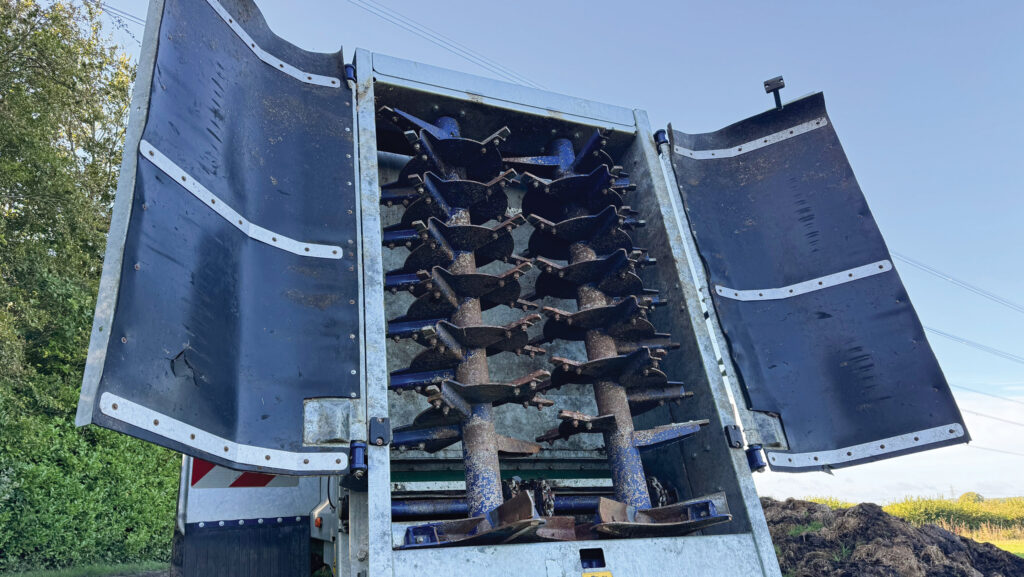
© MAG/Oliver Mark
The regular 820mm-diameter beaters, which are a tad smaller than some of the competition, are each armed with 32 Hardox tips. These deliver a generally consistent spread pattern.
However, the optional hydraulically controlled deflectors on our test model somewhat scuppered that homogeneity.
We had the three-quarter-length versions (£2,000) designed primarily for chicken muck and other low-volume applications.
These are an alternative to a full top-to-bottom setup designed to limit the throw when working along a boundary or, heaven forbid, close to a garden fence.
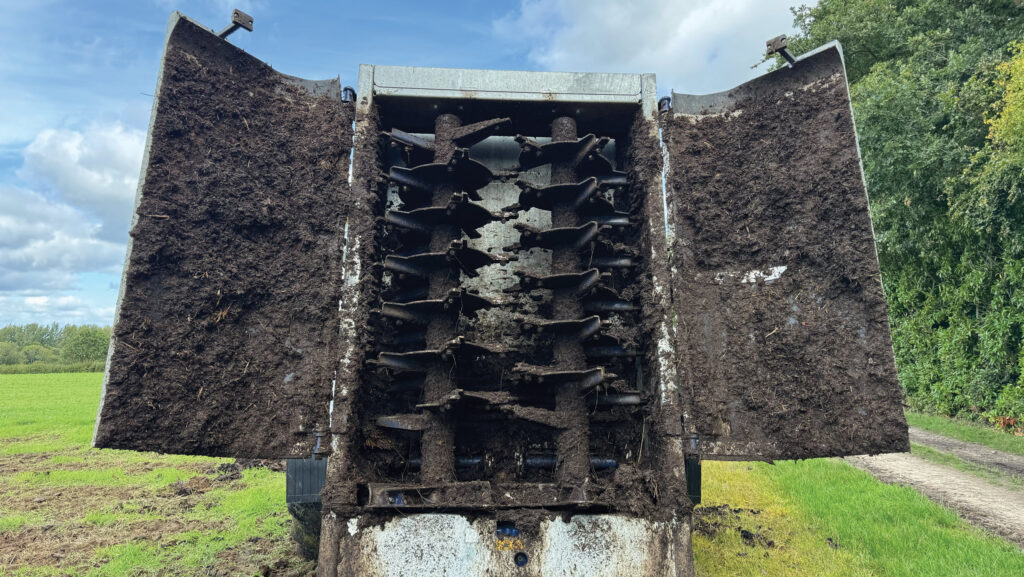
Rubber door linings will be replaced with slipperier PVC © MAG/Oliver Mark
But we found that claggy, well-rotted muck tended to stick to them, even when they were fully open, before dropping off in big, unsightly lumps across the field.
RS says it will address this issue by replacing the deflectors’ rubber lining with slipperier PVC, which should discourage material from adhering.
The doors also tended to drift closed a couple of times per load, though this could easily be solved by fitting lock valves or taps on the hydraulics – something that will be provided on all models from now on.
Other spec details worth noting include LED light covers that close automatically as the slurry door is opened, a wide-angle pto as standard, and the option of a hydraulic jack.
Likes and gripes
Likes
- Solidly built
- Plenty of options to suit budget
- RS Agri is working to remedy all gripes
Gripes
- Deflectors gradually close without lock-off valves
- Claggy muck sticks to deflectors and drops off in lumps
- Material collects on stone guard
Controls
Plenty of control options are offered, from a fully manual setup that requires four double-acting hydraulic spools, to an isobus connection that runs through any universal terminal.
Alternatively, RS can provide a Topcon XD screen for the job.
The mid-range electric control box (£1,200) will likely be a popular option.
It hogs fewer tractor valves and allows conveyor speed to be altered on a small dial, and all the other functions to be worked on toggle switches.
Alternatively, it can be had with electric floor conveyor speed adjustment (£600) but manual controls for the other services.
Buyers keen to track what they are spreading can also opt for a weighing system with or without a spreading monitor to keep track of each load.
FW verdict
With plenty of established rivals, RS Agri will have to work hard to get these new Atlas spreaders in the hands of farmers.
But, like its feeder wagons, they are no two-bit imports, as demonstrated by the £33,500 on-farm starting price for the 16-tonner.
And this figure could quickly rise once several extras have been accounted for, most notable among them the galvanised finish (£2,000), sprung drawbar (£1,650), air/hydraulic brakes (£300) and 300mm wooden greedy boards (£425).
That said, the biggest test for any muckspreader is the longevity of the chains, slats and beds. The omens look good, but there’s no chance of us vouching for this after only a week-long test.

